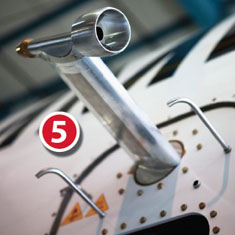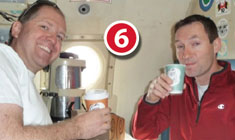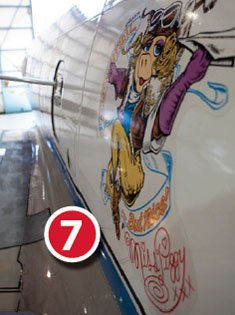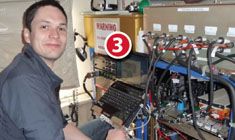

![]() The P3 can remain in the air for up to 11 hours per flight, so having coffee on board is a must. Here, CIRES researchers Harald Stark and Carsten Warneke relax in the plane’s galley.
The P3 can remain in the air for up to 11 hours per flight, so having coffee on board is a must. Here, CIRES researchers Harald Stark and Carsten Warneke relax in the plane’s galley.

![]() N43RF is one of two NOAA WP-3Ds. It features a decal of Miss Piggy with the slogan “Aero-nautical . . . but nice!” The other plane, N42RF, features “Sky-Hopper” Kermit the Frog.
N43RF is one of two NOAA WP-3Ds. It features a decal of Miss Piggy with the slogan “Aero-nautical . . . but nice!” The other plane, N42RF, features “Sky-Hopper” Kermit the Frog.


![]() CIRES scientist Justin Langridge works on an aerosol extinction cavityringdown spectrometer. The P3s participate in a wide variety of environmental research missions in addition to their widely known use in hurricane research and reconnaissance.
CIRES scientist Justin Langridge works on an aerosol extinction cavityringdown spectrometer. The P3s participate in a wide variety of environmental research missions in addition to their widely known use in hurricane research and reconnaissance.

![]() A stuffed version of Japanese anime character Anpanman (see description of his superpowers on page 1) accompanies the PAN-CIMS (Peroxyacetyl Nitrates Chemical Ionization Mass Spectrometer).
A stuffed version of Japanese anime character Anpanman (see description of his superpowers on page 1) accompanies the PAN-CIMS (Peroxyacetyl Nitrates Chemical Ionization Mass Spectrometer).

![]() The outside of the P3 is equipped with a wide array of air inlets for researchers to gather data.
The outside of the P3 is equipped with a wide array of air inlets for researchers to gather data.
On board the NOAA WP-3D (P3) Orion N43RF
Since the mid-1970s, scientists have soared the skies in NOAA’s WP-3D aircraft to investigate the Earth’s atmosphere, hurricanes, severe storms and climate trends.
By Jane Palmer
![]() The P3 can accommodate 18 to 20 crew members and up to 12 scientists or media members. Fully loaded with personnel, scientific equipment and fuel, the P3 weighs in at 135,000lbs.
The P3 can accommodate 18 to 20 crew members and up to 12 scientists or media members. Fully loaded with personnel, scientific equipment and fuel, the P3 weighs in at 135,000lbs.
![]() Prior to takeoff, cool air is pumped into the P3 to keep the inside of the plane and the scientific equipment cool. Flying at low altitudes (reaching a maximum of 27,000 feet) can be hot work, and the instruments would cut out at high temperatures.
Prior to takeoff, cool air is pumped into the P3 to keep the inside of the plane and the scientific equipment cool. Flying at low altitudes (reaching a maximum of 27,000 feet) can be hot work, and the instruments would cut out at high temperatures.



